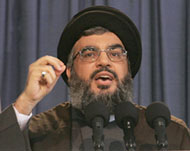Factfile: Hezbollah
Hezbollah is an Islamic resistance group and political party based in Lebanon. Founded by Shia Muslims to resist Israel’s invasion of Lebanon in 1982, the group’s political and military success has made it a model for other Islamic movements worldwide.

History
Hezbollah was founded in the early 1980s by Lebanese Shia who wanted to fight the Israeli army, which since 1982 had occupied a large area of southern Lebanon.
The movement grew quickly after receiving Syrian and Iranian logistical, financial and military support. Its members carried out numerous suicide attacks against Israeli targets inside Lebanon.
By the late 1990s Hezbollah had developed into a sophisticated political party while also funding free schools, hospitals and social programmes for Lebanon’s often impoverished and rural Shia population.
But at the same time, its fighters continued to mount ever more lethal attacks on Israeli forces in Lebanon, leading to an increasing pressure on the Israeli government to pull out.
Israeli defeat
In May 2000 Israel withdrew from all of Lebanon. Hezbollah was widely seen as the cause of the Israeli defeat. Many observers hailed the group as the first Arab military force to defeat an Israeli army.
But while the group’s popularity soared within Lebanon – even among many Lebanese Christians and Sunnis – world powers called for Hezbollah to lay down its arms and enter mainstream politics.
 |
|
Hezbollah supporters in Beirut |
By late 2000 the group was under increasing international pressure to disarm now that the Israelis had left.
A new role
A few months after the Israeli withdrawal from Lebanon, the second Palestinian intifada broke out in October 2000.
The violence offered Hezbollah’s armed wing a new role and purpose. Within months the Shia group had rebranded itself as a defender of all Arabs and Muslims
In October 2000 Hezbollah kidnapped three Israeli soldiers on the Lebanese border and demanded the release of Arab prisoners held by Israel.
In January 2004 Israel released nearly 500 Palestinian and Lebanese prisoners in return for a kidnapped Israeli businessman and the bodies of the four soldiers.
Since the Israeli withdrawal, Hezbollah has also attacked the Shebaa Farms, an Israeli-occupied area of land bordering Southern Lebanon. Hezbollah claims that this 25 square km area is historically Lebanese but the UN and Israel say it was captured from Syria during the 1973 Arab-Israeli war.
The future
Hezbollah’s leader, Hassan Nasrallah, has tried to build the group into the dominant political party among the Lebanese Shia, who are the largest of Lebanon’s 19 religious minorities.
 |
|
Hassan Nasrallah |
The movement’s success at driving Israel out of Lebanon has inspired many other Islamic groups around the Middle East from Hamas in Palestine to Muqtada al-Sadr’s Madhi Army in Iraq.
However, Hezbollah remains dependent on Syria and Iran for funds and arms. The US has frequently called on both countries to stop supporting the group which is today estimated to have several thousand fighters.
Syria has previously offered to disarm Hezbollah if Israel returns the Golan Heights, which it has held since 1967.